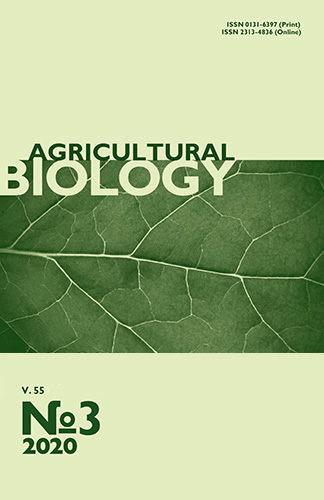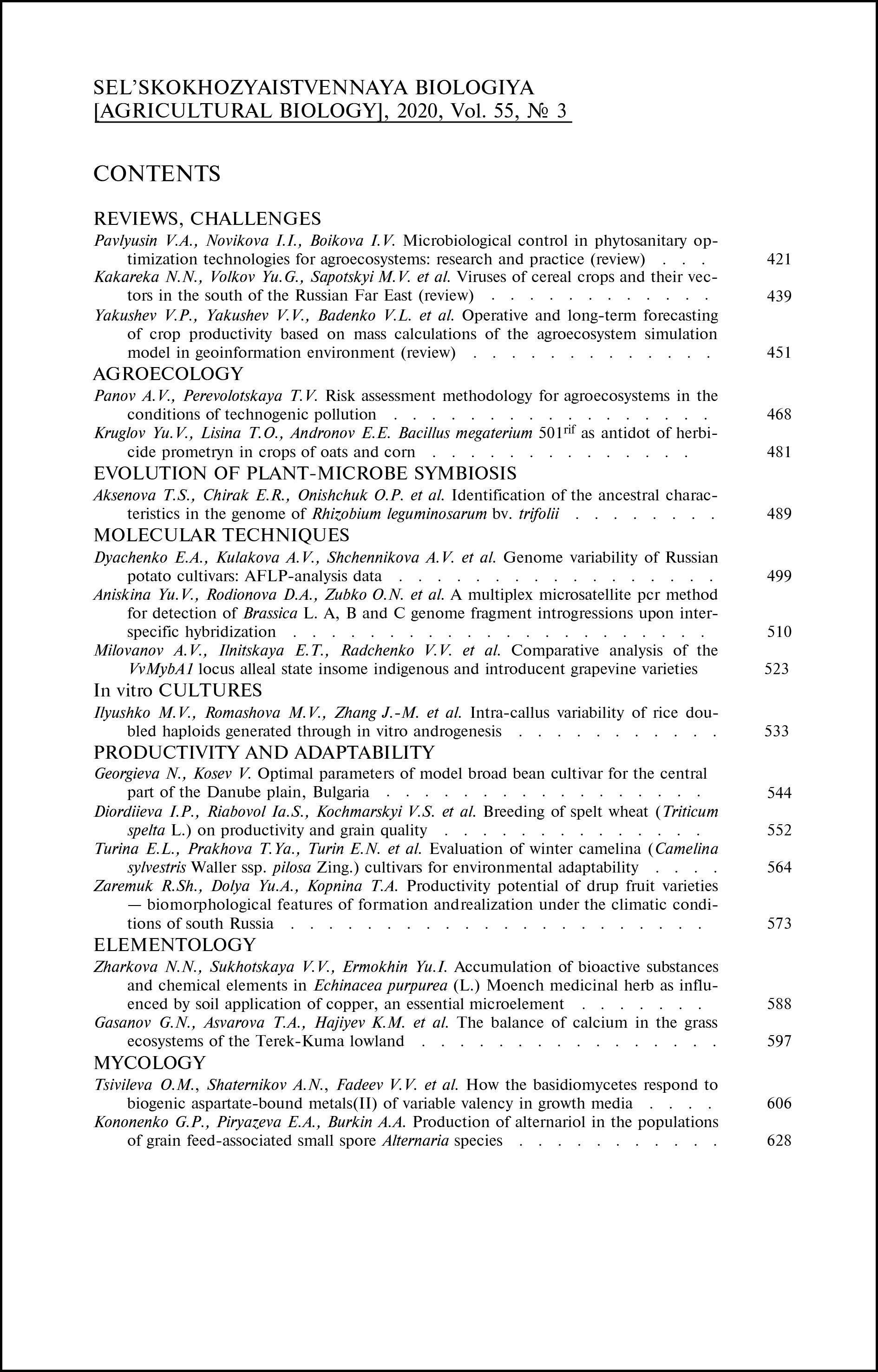doi: 10.15389/agrobiology.2020.3.533eng
UDC: 633.18:575:57.085.23
Acknowledgements:
Supported financially by the Joint Laboratory Program of China, the CIS and Central-Eastern Europe countries as part of the One Belt — One Way Strategy (No. 2016AE6AE001)
INTRA-CALLUS VARIABILITY OF RICE DOUBLED HAPLOIDS GENERATED THROUGH in vitro ANDROGENESIS
M.V. Ilyushko1, M.V. Romashova1, J.-M. Zhang2, L.-W. Deng3, D.-J. Liu4, R. Zhang2, S.S. Guchenko1
1Chaika Federal Research Center of Agricultural Biotechnology of the Far East, 30, ul. Volozhenina, pos. Timityazevskii, Ussuryisk, Primorskii Krai, 692539 Russia, e-mail ilyushkoiris@mail.ru (✉ corresponding author), romashova_1969@mail.ru, lana_svet8@mail.ru;
2Chinese-Russian Center for Science and Technology in Agricultural Cooperation, Heilongjiang Academy of Agricultural Sciences, 368 Xuefu Rd, Nangang, Harbin, Heilongjiang, China 150086, e-mail zjm312@aliyun.com, zr0705@126.com;
3Biotechnology Research Institute, Heilongjiang Academy of Agricultural Sciences, 368 Xuefu Rd, Nangang, Harbin, Heilongjiang, China 150086, e-mail lucydlw@163.com;
4Crop Resources Institute, Heilongjiang Academy of Agricultural Sciences, 368 Xuefu Rd, Nangang, Harbin, Heilongjiang, China 150086, e-mail dongdong415@126.com
ORCID:
Ilyushko M.V. orcid.org/0000-0001-7042-8641
Romashova M.V. orcid.org/0000-0002-7426-8523
Zhang J.-M. orcid.org/0000-0003-0662-5098
Deng L.-W. orcid.org/0000-0002-4325-0080
Lui D.-J. orcid.org/0000-0002-1002-5266
Zhang R. orcid.org/0000-0002-2338-7469
Guchenko S.S. orcid.org/0000-0003-3492-8934
Received June 7, 2019
In vitro androgenesis is among the leading methods in creating source material for crop breeding. Many breeders a priori consider the seed progeny of any doubled haploid a new line, regardless of which callus the line was obtained from. In practice, it often turns out that in field conditions the lines from one callus are outwardly identical, so the breeders discard them, leaving two or three of ones for further work. The validity of such a controversial approach requires experimental confirmation or refutation of polymorphism and genetic variability of doubled haploids of the same callus line. About 100 genes of rice resistance to Pyricularia oryzae Cav. [Magnaporthe grisea (Hebert Barr.)] are known of which Pi-ta и Pi-ta2 are the most relevant for the Russian Far East. This paper is the first to report intracallus morphological polymorphism and genetic variability for Pi-ta и Pi-ta2 genes due to gametoclonal and somaclonal variability of rice Oryza sativa L. doubled haploids derived from a hybrid plant via in vitro androgenesis. For the first time, a monomorphism in the absence of genetic variability due to callus cell clonal reproduction (mitotic division) was revealed among doubled haploids produced by the same callus line. Our work aimed to study the intracallus morphological and genetic variability of Oryza sativa L. doubled rice haploids derived in vitro androgenetically from a hybrid plant. Experiments were performed in 2017-2018 at the Federal Research Center of Agricultural Biotechnology of the Far East (Russia) and the Crop Resources Institute, Heilongjiang Academy of Agricultural Sciences, (China). A F1 Don 4237 ½ Dolynniy rice hybrid was used. A total of 386 anthers of this hybrid were cultured in vitro with the callus formation rate of 17.1%. Six of eighteen callus lines producing green regenerants were selected for further study. Two seeds of each doubled haploid line were sown in soil and grown in plastic pots (a culture room, 24 °С, 5000 lux, 16 hours/8 hours day/night). One plant of each pair was cut 90 days after sowing to assess the presence/absence of anthocyanin coloration. Plant growth stages (late tillering, stem extension, heading, and flowering) were recorded. Doubled haploids that reached the first two of these stages were assigned to a later group, and those that reached the heading and flowering stages were combined into an early group. The presence or absence of awns, their length and color were estimated after maturation. DNA was extracted from fresh leaves by CTAB method. The DNA quality and quantity were estimated electrophoretically using a 1.0 % agarose gel. Alleles of the Pi-ta and Pi-ta2 genes which determine blast resistance were detected by PCR method. Plants of the Chinese monogenic variety K12 were a positive control for Pi-ta gene, and varieties K27 for Pi-ta2 gene. The doubled haploids of two callus lines, 7.2.2 and 21.2.1, are monomorphic without genetic variability for both resistance genes, Pi-ta and Pi-ta2. Plant seeds of each callus line (7.2.2 and 21.2.1) will be further combined into two separate breeding lines to intensify breeding due to a larger number of seeds. Doubled haploids of the callus lines 1.2.1, 4.1.2, 8.2.1, 36.2.3 are polymorphic in awn formation, plant growth stage and anthocyanin pigmentation of stem cuts. The callus line 8.2.1 is genetically variable (ten plants carried alleles of both resistance genes, Pi-ta and Pi-ta2, eight plants possessed none of the alleles, and in 26 plants only Pi-ta2allele was detected). Thus, upon callus formation via in vitro androgenesis, the two opposite processes occurred are somaclonal variation and cell cloning. Somaclonal variation leads to polymorphism of callus cells and plant-regenerants, while cell cloning determines intra-callus uniformity, as well as the uniformity of some regenerants (and, in many cases, all regenerants derived from the same anther). Monomorphic doubled haploids, after a preliminary assessment for morphological traits and molecular characteristics, comprises a single selection sample.
Keywords: Oryza sativa, in vitro androgenesis, intra-callus variability, rice blast, resistance, Pi-ta, Pi-ta2.
REFERENCES
- Germanà M.A.Anther culture for haploid and doubled haploid production. Plant Cell Tiss. Organ. Cult., 2011, 104(3): 283-300 CrossRef
- Ferrie A.M.R., Caswell K.L. Isolated microspore culture techniques and recent progress for haploid and doubled haploid plant production. Plant Cell Tiss. Organ. Cult., 2011, 104(3): 301-309 CrossRef
- Dunwell J.M. Haploids in flowering plants: origins and exploitation. Plant Biotechnology Journal, 2010, 8(4): 377-424 CrossRef
- Mishra R., Rao G.J.N. In-vitro androgenesis in rice: advantages, constraints and future prospects. Rice Science, 2016, 23(2): 57-68 CrossRef
- Sarao N.K., Gosal S.S. In vitro androgenesis for accelerated breeding in rice. In: Biotechnologies of crop improvement. Vol. 1. S.S. Gosal, S.H. Wani (eds.). Springer, Cham, 2018: 407-435 CrossRef
- Datta S.K. Androgenic haploids: factors controlling development and its application in crop improvement. Current Sci., 2005, 89(11): 1870-1878.
- Mishra R., Rao G.J.N., Rao R.N., Kaushal P. Development and characterization of elite doubled haploid lines from two indica rice hybrids. Rice Science, 2015, 22(6): 290-299 CrossRef
- Lapitan V.C., Redoña E.D., Abe T., Brar D. Molecular characterization and agronomic performance of DH lines from the F1 of indica and japonica cultivars of rice (Oryza sativa L.). Field Crops Research, 2009, 112(2-3): 222-228 CrossRef
- Ilyushko M.V., Romashova M.V. Variability of rice haploids obtained from in vitro anther culture. Russian Agricultural Sciences, 2019, 45(3): 243-246 CrossRef
- Sibikeeva Yu.E., Sibikeev S.N. Genetika, 2014, 50(7): 831-839 CrossRef (in Russ.).
- Kruglova N.N. Agrarnaya Rossiya, 2009, 1: 34-38 (in Russ.).
- Heberle-Bors E. In vitro haploid formation from pollen: a critical review. Theoret. Appl. Genetics, 1985, 71: 361-374 CrossRef
- Ilyushko M.V., Romashova M.V. Argarnyi vestnik Primor'ya, 2018, 1(9): 5-8 (in Russ.).
- Sel'dimirova O.A., Kruglova N.N. Uspekhi sovremennoi biologii, 2014, 134(5): 476-487 (in Russ.).
- Mishra R., Rao G.J.N., Rao R.N., Kaushal P. Development and characterization of elite doubled haploid lines from two indica rice hybrids. Rice Science, 2015, 22(6): 290-299 CrossRef
- Wu Y., Xiao N., Chen Y., Yu L., Pan C., Li Y., Zhang X., Huang N., Ji H., Dai Z., Chen X., Li A. Comprehensive evaluation of resistance effects of pyramiding lines with different broad-spectrum resistance genes against Magnaporthe oryzae in rice (Oryza sativa L.). Rice, 2019, 12: 11 CrossRef
- Sankin A.Yu., Lelyavskaya V.N., Sun I.T. Uspekhi sovremennoi nauki, 2017, 2(10): S. 26-28 (in Russ.).
- Dai X.-J., Yan Y.-Z., Zhou L., Liang M.-Z., Fu X.-C., Chen L.-B. Distribution research of blast resistance genes Pita, Pib, Pi9 and Pikm in blast-resistant rice resources. Life Sci. Research, 2012, 16(4): 340-356 CrossRef
- Orasen G., Greco R., Puja E., Pozzi C., Stile M.R. Blast resistance R genes pyramiding in temperate japonica rice. Euphytica, 2020, 216: 40 CrossRef
- Wang J.C., Correll J.C., Jia Y. Characterization of rice blast resistance genes in rice germplasm with monogenic lines and pathogenicity assays. Crop Protection, 2015, 72: 132-138 CrossRef
- Ilyushko M.V., Fisenko P.V., Sunitskaya T.V., Guchenko S.S., CHzhan TS., Den L.-V., Kostylev P.I. Zernovoe khozyaistvo Rossii, 2017, 4: 41-45 (in Russ.).
- Ilyushko M.V., Romashova M.V., Fisenko P.V., Sunitskaya T.V., Guchenko S.S., Lelyavskaya V.N. Vestnik zashchity rastenii, 2019, 1(99): 36-39 CrossRef (in Russ.).
- Ilyushko M.V., Romashova M.V. Dal'nevostochnyi agrarnyi vestnik, 2017, 4(44): 37-45 (in Russ.).
- Gennaya inzheneriya rastenii. Laboratornoe rukovodstvo /Pod redaktsiei Dzh. Dreipera, R. Skotta, F. Armitidzha, R. Uoldena [Genetic engineering of plants. Laboratory manual]. Moscow, 1991 (in Russ.).
- Farrell T.C., Fox K.M., Williams R.L., Fukai S. Genotypic variation for cold tolerance during reproductive development in rice: screening with cold air and cold water. Field Crops Research, 2006, 98(2-3): 178-194 CrossRef
- Ilyushko M.V., Romashova M.V. Rossiiskaya sel'skokhozyaistvennaya nauka, 2020, 3: 14-17 CrossRef (in Russ.).
- Wang Z., Jia Y., Fjellstrom R.G. The relationship between the rice blast resistance genes Pi-ta and Pi-ta2. Journal of Zhejiang wanly university, 2004, 17(2): 91-92.
- Integrated Rice Science Database. Available: http://shigen.nig.ac.jp/rice/oryzabase/gene/detail/947. Accessed: 30.08.2018.
- Ramkumar G., Madhav M.S., Rama Devi S.J.S., Manimaran P., Mohan K.M., Prasad M.S., Balachandran S.M., Neeraja C.N., Sundaram R.M., Viraktamath B.C. Nucleotide diversity of Pita, a major blast redistance gene and identification of its minimal promoter. Gene, 2014, 546(2): 250-256 CrossRef
- Ma J.-T., Zhang G.-M., Xin A.-H., Zhang L.-Y., Deng L.-W., Wang Y.-L., Wang Y., Ran Y., Gong X.-J., Ge X.-L., Yang X.-F. Comparison of pathogenicity of Pyricularia oryzae under different genetic backgrounds. Acta Agronomica Sinica, 2015, 41(12): 1791-1801 CrossRef
- Yamamoto T., Soeda Y., Nishikawa A., Hirohara H. A study of somaclonal variation for rice improvement induced by three kinds of anther-derived cell culture techniques. Plant Tissue Culture Letters, 1994, 11(2): 116-121 CrossRef
- Ezhova T.A., Bagrova A.M., Khartina G.A., Gostimskii S.A. Genetika,1989, XXV(5): 878-885 (in Russ.).
- Kuznetsova O.I., Ash O.A., Gostimskij S.A. The effect of duration of callus culture on the accumulation of genetic alteration in pea Pisum sativum L. Russian Journal of Genetics, 2006, 42(5): 555-562 CrossRef
- Scowcroff W.R. Somaclonal variation: the myth of clonal uniformit. In: Genetic flux in plant. B. Hohn, E.S. Dennis (eds.). Wien, New York: Springer-Verlas, 1985: 217-245 CrossRef
- Osipova E.S., Koveza O.V., Gostimskij S.A., Troitskij A.V., Dolgikh Yu.L., Shamina Z.B. Analysis of specific RAPD and ISSR fragments in maize (Zea mays L.) somaclones and development of SCAR markers on their basis. Russian Journal of Genetics, 2003, 39(12): 1412-1419 CrossRef












